Evaluation of Recombinant Foot-and-Mouth Disease SAT2 Vaccine Strain in Terms of Antigen Productivity, Virus Inactivation Kinetics, and Immunogenicity in Pigs for Domestic Antigen Bank
Abstract
1. Introduction
2. Materials and Methods
2.1. Cells and Viruses
2.2. Determination of Optimal Conditions for SAT2 ZIM-R Antigen Production
2.3. Determination of Optimal pH for SAT2 ZIM-R Antigen Production
2.4. Virus Titration
2.5. Quantification of FMDV Particles
2.6. Preparation of Vaccine Antigen Using a Flask Shaker and 2 L Bioreactor
2.7. FMDV Inactivation Kinetics
2.8. Animal Experiments
2.9. Virus Neutralization Test
2.10. ELISA for the Detection of SP Antibodies Against FMDV SAT2
2.11. Statistical Analysis
3. Results
3.1. Optimization of Conditions for SAT2 ZIM-R Antigen Production
3.2. Determination of Optimal pH for SAT2 ZIM-R Antigen Production
3.3. Comparison of Antigen Productivity According to Production Scale
3.4. BEI Inactivation Kinetics of SAT2 ZIM-R
3.5. Immunogenicity of pSAT2-ZIM-R in Pigs
4. Discussion
5. Conclusions
Author Contributions
Funding
Institutional Review Board Statement
Informed Consent Statement
Data Availability Statement
Conflicts of Interest
References
- Grubman, M.J.; Baxt, B. Foot-and-mouth disease. Clin. Microbiol. Rev. 2004, 17, 465–493. [Google Scholar] [CrossRef] [PubMed]
- Sharma, G.K.; Mohapatra, J.K.; Mahajan, S.; Matura, R.; Subramaniam, S.; Pattnaik, B. Comparative evaluation of non-structural protein-antibody detecting ELISAs for foot-and-mouth disease sero-surveillance under intensive vaccination. J. Virol. Methods 2014, 207, 22–28. [Google Scholar] [CrossRef] [PubMed]
- Rueckert, R.R.; Wimmer, E. Systematic nomenclature of picornavirus proteins. J. Virol. 1984, 50, 957–959. [Google Scholar] [CrossRef]
- Liu, Z.; Shao, J.; Zhao, F.; Zhou, G.; Gao, S.; Liu, W.; Lv, J.; Li, X.; Li, Y.; Chang, H. Chemiluminescence immunoassay for the detection of antibodies against the 2C and 3ABC nonstructural proteins induced by infecting pigs with foot-and-mouth disease virus. Clin. Vaccine Immunol. 2017, 24, e00153–e00157. [Google Scholar] [CrossRef]
- Mateo, R.; Díaz, A.; Baranowski, E.; Mateu, M.G. Complete alanine scanning of intersubunit interfaces in a foot-and-mouth disease virus capsid reveals critical contributions of many side chains to particle stability and viral function. J. Biol. Chem. 2003, 278, 41019–41027. [Google Scholar] [CrossRef][Green Version]
- Curry, S.; Fry, E.; Blakemore, W.; Ghazaleh, R.A.; Jackson, T.; King, A.; Lea, S.; Newman, J.; Rowlands, D.; Stuart, D. Perturbations in the surface structure of A22 Iraq foot-and-mouth disease virus accompanying coupled changes in host cell specificity and antigenicity. Structure 1996, 4, 135–145. [Google Scholar] [CrossRef] [PubMed]
- Ellard, F.M.; Drew, J.; Blakemore, W.E.; Stuart, D.I.; King, A.M. Evidence for the role of His-142 of protein 1C in the acid-induced disassembly of foot-and-mouth disease virus capsids. J. Gen. Virol. 1999, 80, 1911–1918. [Google Scholar] [CrossRef]
- Mateo, R.; Luna, E.; Rincón, V.; Mateu, M.G. Engineering viable foot-and-mouth disease viruses with increased thermostability as a step in the development of improved vaccines. J. Virol. 2008, 82, 12232–12240. [Google Scholar] [CrossRef]
- Acharya, R.; Fry, E.; Stuart, D.; Fox, G.; Rowlands, D.; Brown, F. The three-dimensional structure of foot-and-mouth disease virus at 2.9 Å resolution. Nature 1989, 337, 709–716. [Google Scholar] [CrossRef]
- Abd, M.T.; Mshary, G.S.; Kadhim, A.N.; Khamees, H.A. The Outbreak of Foot and Mouth Disease Serotype Sat-2 Infection in Al-Muthanna Province of Iraq. J. Vet. Physiol. Pathol. 2024, 3, 7–10. [Google Scholar] [CrossRef]
- Bastos, A.; Haydon, D.; Sangare, O.; Boshoff, C.; Edrich, J.; Thomson, G. The implications of virus diversity within the SAT 2 serotype for control of foot-and-mouth disease in sub-Saharan Africa. J. Gen. Virol. 2003, 84, 1595–1606. [Google Scholar] [CrossRef]
- Di Nardo, A.; Shaw, A.E.; Gondard, M.; Wadsworth, J.; Girault, G.; Parekh, K.; Ludi, A.; Mioulet, V.; Bernelin-Cottet, C.; Hicks, H.M.; et al. Eastern Africa Origin of SAT2 Topotype XIV Foot-and-Mouth Disease Virus Outbreaks, Western Asia, 2023. Emerg. Infect. Dis. 2025, 31, 368. [Google Scholar] [CrossRef] [PubMed]
- Jo, H.-E.; You, S.-H.; Choi, J.-H.; Ko, M.-K.; Shin, S.H.; Song, J.; Jo, H.; Lee, M.J.; Kim, S.-M.; Kim, B. Evaluation of novel inactivated vaccines for the SAT 1, SAT 2 and SAT 3 serotypes of foot-and-mouth disease in pigs. Virol. J. 2019, 16, 156. [Google Scholar] [CrossRef] [PubMed]
- Park, S.; Kim, J.Y.; Ryu, K.-H.; Kim, A.-Y.; Kim, J.; Ko, Y.-J.; Lee, E.G. Production of a foot-and-mouth disease vaccine antigen using suspension-adapted BHK-21 cells in a bioreactor. Vaccines 2021, 9, 505. [Google Scholar] [CrossRef] [PubMed]
- Kärber, G. Beitrag zur kollektiven behandlung pharmakologischer reihenversuche. Arch. Exp. Pathol. Pharmakol. 1931, 162, 480–483. [Google Scholar] [CrossRef]
- Kim, A.-Y.; Park, S.Y.; Park, S.H.; Jin, J.S.; Kim, E.-S.; Kim, J.Y.; Park, J.-H.; Ko, Y.-J. Validation of Pretreatment Methods for the In-Process Quantification of Foot-and-Mouth Disease Vaccine Antigens. Vaccines 2021, 9, 1361. [Google Scholar] [CrossRef]
- WOAH. WOAH Terrestrial Manual 2022. In Foot and Mouth Disease (Infection with Foot and Motu Disease Virus); WOAH: Paris, France, 2022. [Google Scholar]
- Kotecha, A.; Seago, J.; Scott, K.; Burman, A.; Loureiro, S.; Ren, J.; Porta, C.; Ginn, H.M.; Jackson, T.; Perez-Martin, E. Structure-based energetics of protein interfaces guides foot-and-mouth disease virus vaccine design. Nat. Struct. Mol. Biol. 2015, 22, 788–794. [Google Scholar] [CrossRef]
- Doel, T.; Chong, W. Comparative immunogenicity of 146S, 75S and 12S particles of foot-and-mouth disease virus. Arch. Virol. 1982, 73, 185–191. [Google Scholar] [CrossRef]
- Scott, K.A.; Maake, L.; Botha, E.; Theron, J.; Maree, F.F. Inherent biophysical stability of foot-and-mouth disease SAT1, SAT2 and SAT3 viruses. Virus Res. 2019, 264, 45–55. [Google Scholar] [CrossRef]
- Aarthi, D.; Rao, K.A.; Robinson, R.; Srinivasan, V. Validation of binary ethyleneimine (BEI) used as an inactivant for foot and mouth disease tissue culture vaccine. Biologicals 2004, 32, 153–156. [Google Scholar] [CrossRef]
- Wu, P.; Rodríguez, Y.Y.; Hershey, B.J.; Tadassa, Y.; Dodd, K.A.; Jia, W. Validation of a binary ethylenimine (BEI) inactivation procedure for biosafety treatment of foot-and-mouth disease viruses (FMDV), vesicular stomatitis viruses (VSV), and swine vesicular disease virus (SVDV). Vet. Microbiol. 2021, 252, 108928. [Google Scholar] [CrossRef] [PubMed]
- Li, X.-R.; Yang, Y.-K.; Wang, R.-B.; An, F.-L.; Zhang, Y.-D.; Nie, J.-Q.; Ahamada, H.; Liu, X.-X.; Liu, C.-L.; Deng, Y. A scale-down model of 4000-L cell culture process for inactivated foot-and-mouth disease vaccine production. Vaccine 2019, 37, 6380–6389. [Google Scholar] [CrossRef] [PubMed]
- Hassan, A.I. Effect of different culture systems on the production of foot and mouth disease trivalent vaccine. Vet. World 2016, 9, 32. [Google Scholar] [CrossRef]
- Ahuja, S.; Jain, S.; Ram, K. Application of multivariate analysis and mass transfer principles for refinement of a 3-L bioreactor scale-down model—When shake flasks mimic 15,000-L bioreactors better. Biotechnol. Prog. 2015, 31, 1370–1380. [Google Scholar] [CrossRef] [PubMed]
- Kim, J.Y.; Park, S.Y.; Jin, J.S.; Kim, D.; Park, J.-H.; Park, S.H.; Ko, Y.-J. Efficacy of binary ethylenimine in the inactivation of foot-and-mouth disease virus for vaccine production in South Korea. Pathogens 2023, 12, 760. [Google Scholar] [CrossRef] [PubMed]
- Sarkar, A.; Selvan, R.P.T.; Kishore, S.; Ganesh, K.; Bhanuprakash, V. Comparison of different inactivation methods on the stability of Indian vaccine strains of foot and mouth disease virus. Biologicals 2017, 48, 10–23. [Google Scholar] [CrossRef]
- Ismail, A.; El-Mahdy, S.; Mossad, W.; Abd El-Krim, A.; Abou El-Yazid, M.; Ali, S. Optimization of the inactivation process of FMD virus serotype SAT-2 by binary ethyleneimine (BEI). J. Vet. Adv. 2013, 3, 117–124. [Google Scholar][Green Version]
- Doel, T.; Baccarini, P. Thermal stability of foot-and-mouth disease virus. Arch. Virol. 1981, 70, 21–32. [Google Scholar] [CrossRef]
- Gubbins, S.; Paton, D.J.; Dekker, A.; Ludi, A.B.; Wilsden, G.; Browning, C.F.; Eschbaumer, M.; Barnabei, J.; Duque, H.; Pauszek, L.L. Predicting cross-protection against foot-and-mouth disease virus strains by serology after vaccination. Front. Vet. Sci. 2022, 9, 1027006. [Google Scholar] [CrossRef]
- Kim, J.; Lee, S.H.; Kim, H.-H.; Shin, S.-H.; Park, S.-H.; Park, J.-H.; Park, C.-K. An Alternative Serological Measure for Assessing Foot-and-Mouth Disease Vaccine Efficacy against Homologous and Heterologous Viral Challenges in Pigs. Vaccines 2023, 12, 10. [Google Scholar] [CrossRef]

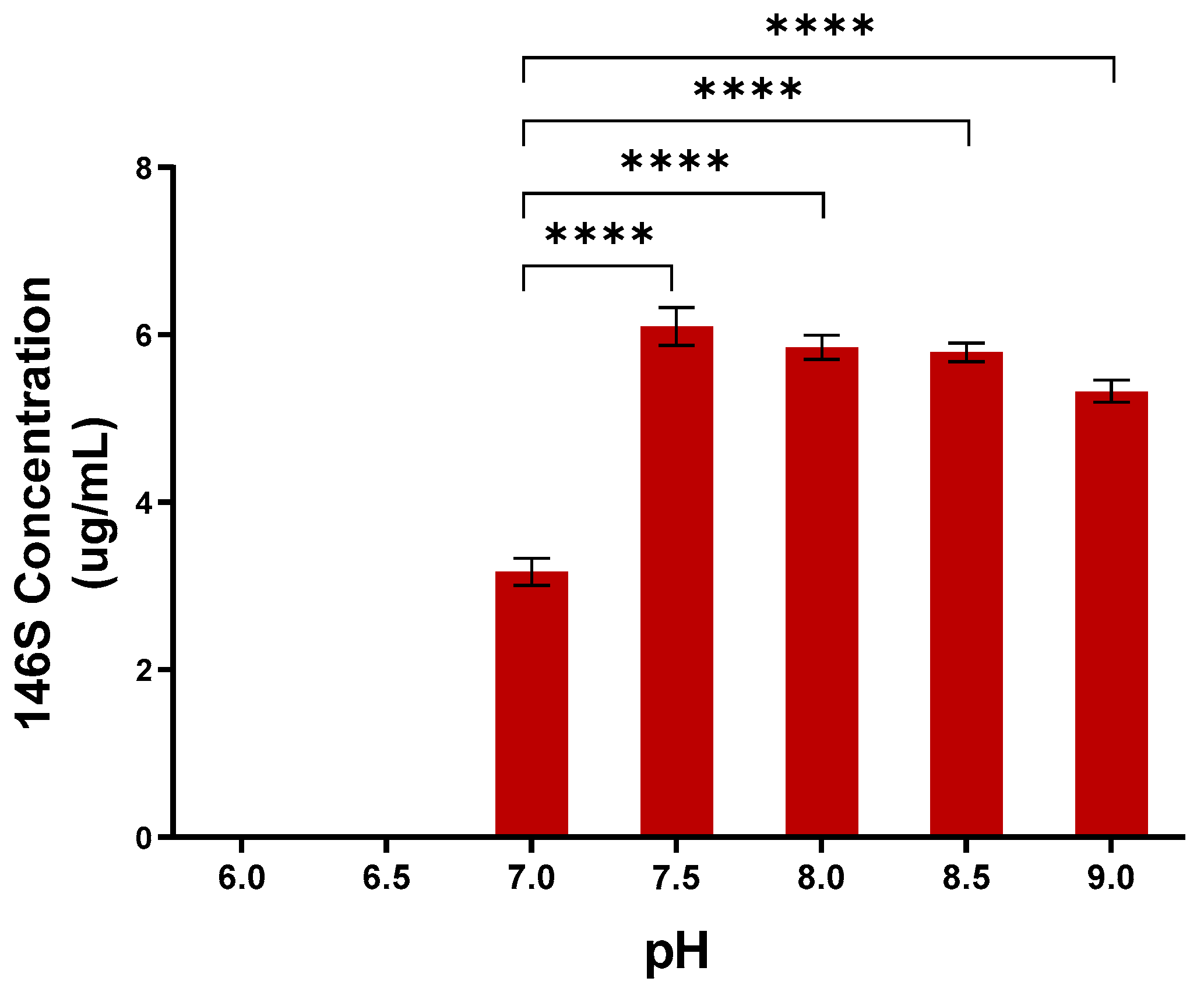
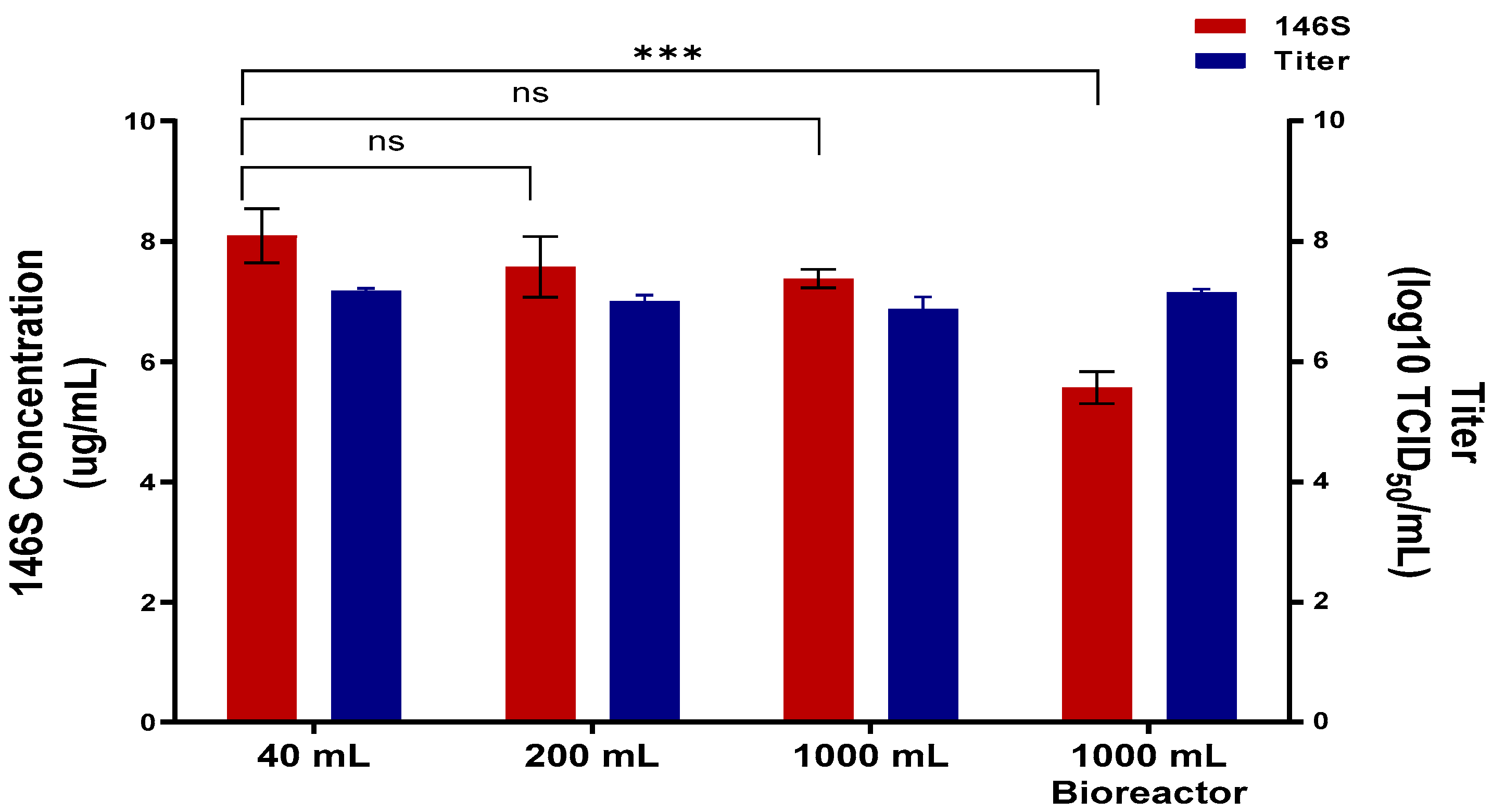
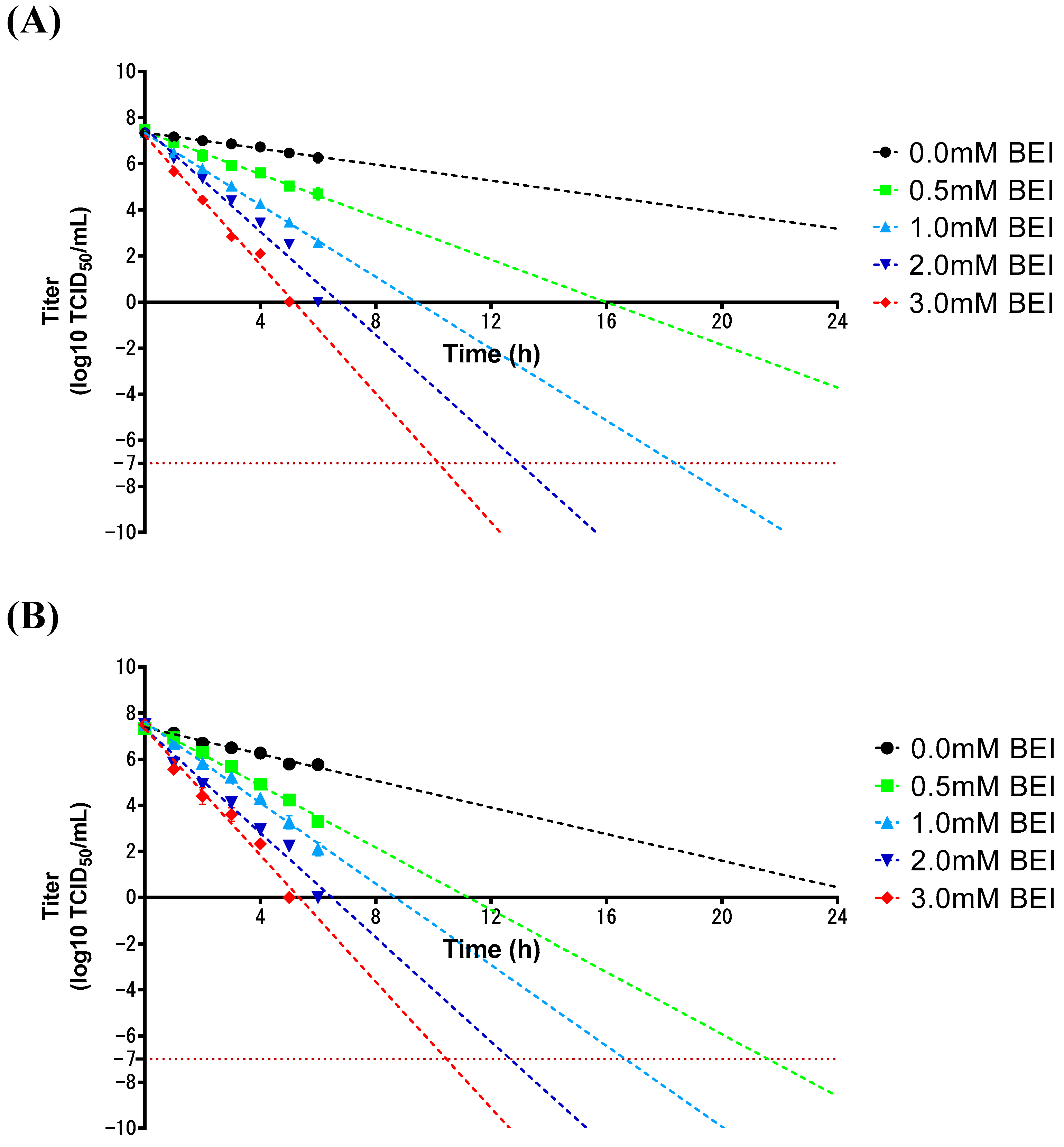
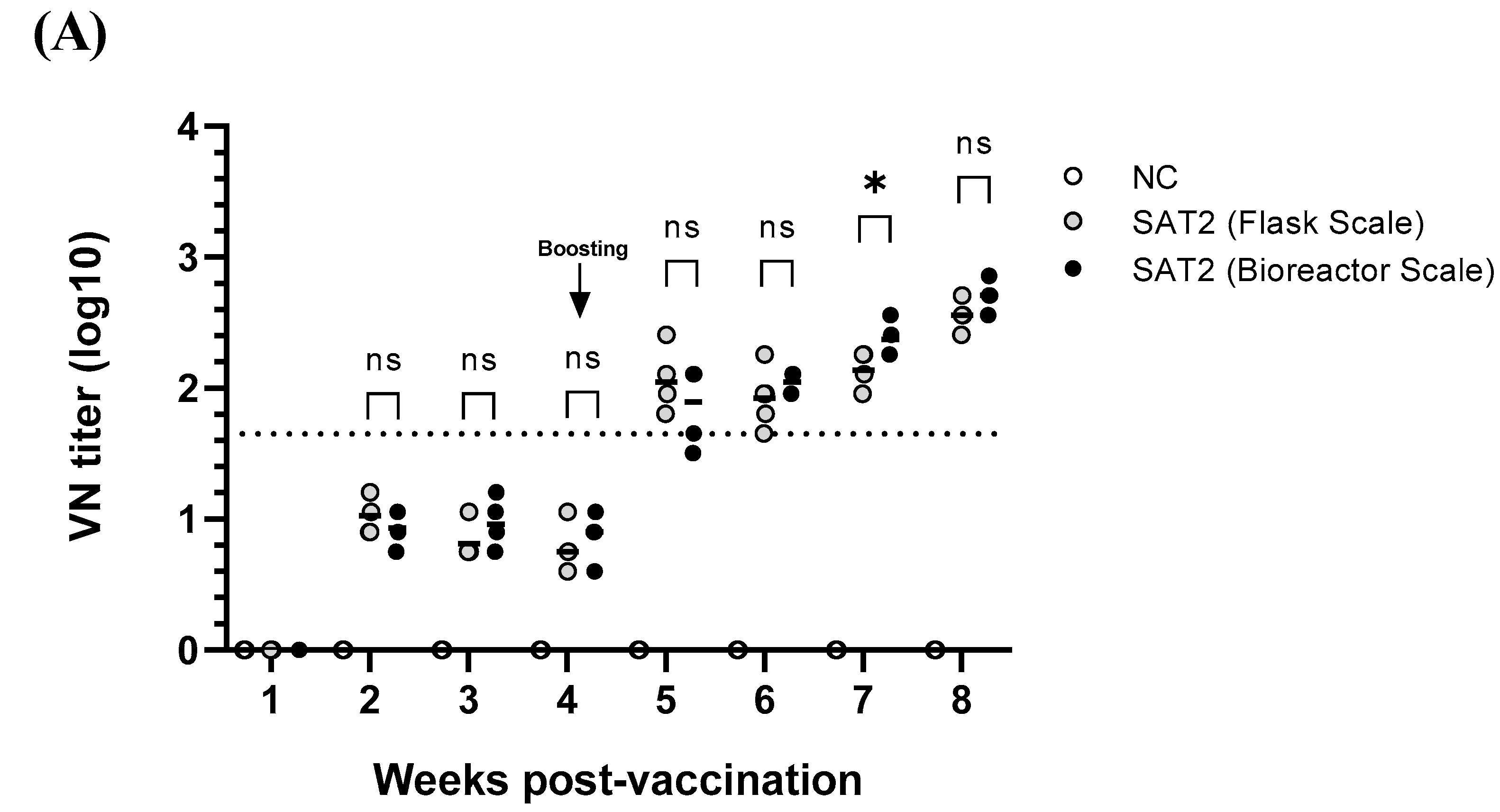
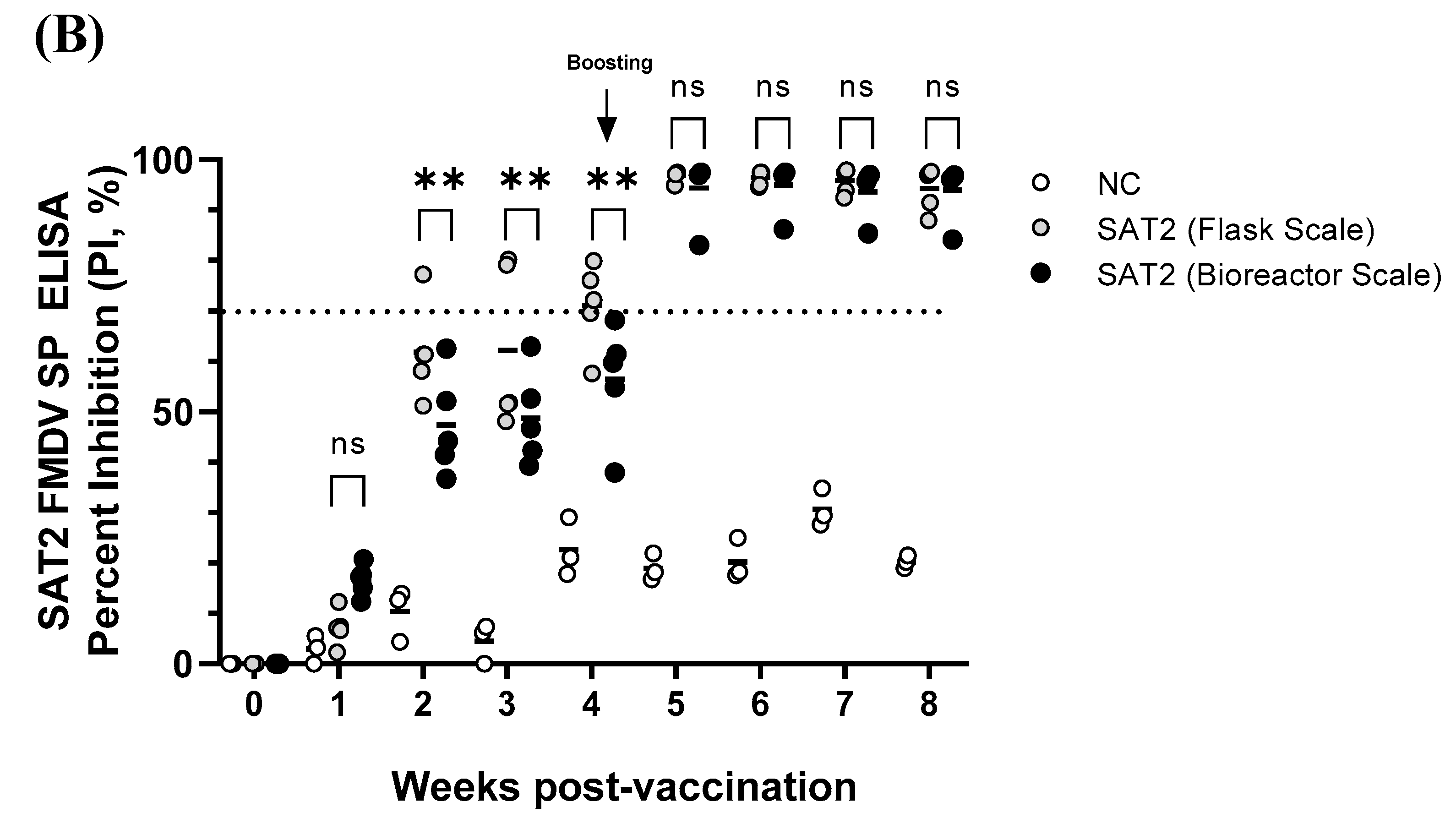
| BEI | 26 °C | 37 °C | |||||||
|---|---|---|---|---|---|---|---|---|---|
| Concentration | 0 h | 6 h | p Value | 24 h | p Value | 6 h | p Value | 24 h | p Value |
| 0.0 mM BEI | 4.19 ± 0.38 | 4.12 ± 0.18 | 0.9296 | 4.06 ± 0.22 | 0.7733 | 3.87 ± 0.05 | 0.3810 | 3.79 ± 0.26 | 0.2243 |
| 0.5 mM BEI | 4.19 ± 0.38 | 4.14 ± 0.07 | 0.9694 | 3.68 ± 0.17 | 0.0428 | 3.97 ± 0.10 | 0.6057 | 3.64 ± 0.69 | 0.0743 |
| 1.0 mM BEI | 4.19 ± 0.38 | 4.11 ± 0.12 | 0.9082 | 3.80 ± 0.07 | 0.1342 | 3.90 ± 0.16 | 0.4403 | 2.68 ± 0.18 | <0.0001 |
| 2.0 mM BEI | 4.19 ± 0.38 | 3.89 ± 0.16 | 0.2767 | 3.75 ± 0.17 | 0.0813 | 4.10 ± 0.13 | 0.9267 | 1.95 ± 0.14 | <0.0001 |
| 3.0 mM BEI | 4.19 ± 0.38 | 3.69 ± 0.13 | 0.0443 | 3.43 ± 0.28 | 0.0022 | 3.84 ± 0.19 | 0.3078 | 1.93 ± 0.31 | <0.0001 |
Disclaimer/Publisher’s Note: The statements, opinions and data contained in all publications are solely those of the individual author(s) and contributor(s) and not of MDPI and/or the editor(s). MDPI and/or the editor(s) disclaim responsibility for any injury to people or property resulting from any ideas, methods, instructions or products referred to in the content. |
© 2025 by the authors. Licensee MDPI, Basel, Switzerland. This article is an open access article distributed under the terms and conditions of the Creative Commons Attribution (CC BY) license (https://creativecommons.org/licenses/by/4.0/).
Share and Cite
Kim, J.Y.; Park, S.Y.; Lee, G.; Kwon, M.; Jin, J.S.; Park, J.-H.; Ko, Y.-J. Evaluation of Recombinant Foot-and-Mouth Disease SAT2 Vaccine Strain in Terms of Antigen Productivity, Virus Inactivation Kinetics, and Immunogenicity in Pigs for Domestic Antigen Bank. Vaccines 2025, 13, 704. https://doi.org/10.3390/vaccines13070704
Kim JY, Park SY, Lee G, Kwon M, Jin JS, Park J-H, Ko Y-J. Evaluation of Recombinant Foot-and-Mouth Disease SAT2 Vaccine Strain in Terms of Antigen Productivity, Virus Inactivation Kinetics, and Immunogenicity in Pigs for Domestic Antigen Bank. Vaccines. 2025; 13(7):704. https://doi.org/10.3390/vaccines13070704
Chicago/Turabian StyleKim, Jae Young, Sun Young Park, Gyeongmin Lee, Mijung Kwon, Jong Sook Jin, Jong-Hyeon Park, and Young-Joon Ko. 2025. "Evaluation of Recombinant Foot-and-Mouth Disease SAT2 Vaccine Strain in Terms of Antigen Productivity, Virus Inactivation Kinetics, and Immunogenicity in Pigs for Domestic Antigen Bank" Vaccines 13, no. 7: 704. https://doi.org/10.3390/vaccines13070704
APA StyleKim, J. Y., Park, S. Y., Lee, G., Kwon, M., Jin, J. S., Park, J.-H., & Ko, Y.-J. (2025). Evaluation of Recombinant Foot-and-Mouth Disease SAT2 Vaccine Strain in Terms of Antigen Productivity, Virus Inactivation Kinetics, and Immunogenicity in Pigs for Domestic Antigen Bank. Vaccines, 13(7), 704. https://doi.org/10.3390/vaccines13070704





